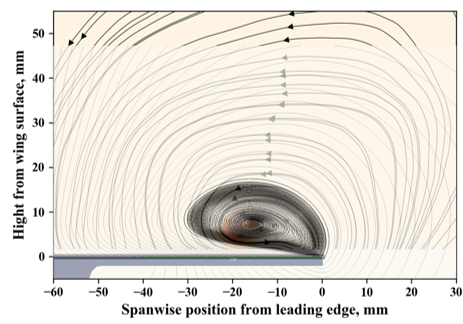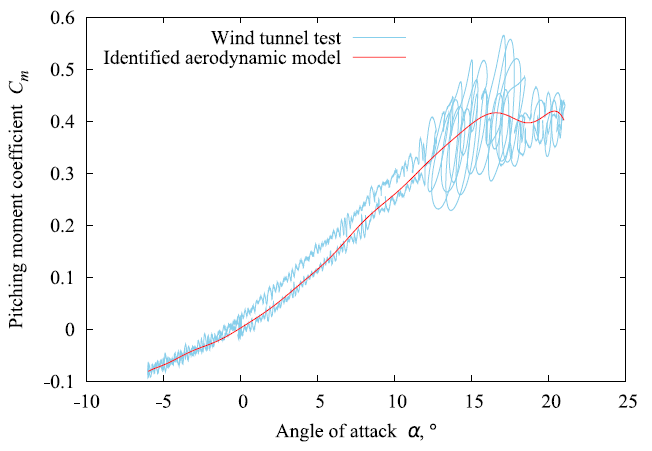Modeling and Identifying Dynamic Derivatives of a Moving Delta-Wing Aircraft using Magnetic Suspension and Balance System by Gaussian Basis Functions
JAXA Supercomputer System Annual Report April 2020-March 2021
Report Number: R20EDA201A03
Subject Category: Aeronautical Technology
- Responsible Representative: Hiroki Sugiura, Senior Researcher, Aerodynamics Research Unit, Aeronautical Technology Directorate
- Contact Information: Hiroki Sugiura,Aerodynamics Research Unit, Aeronautical Technology Directorate(sugiura.hiroki@jaxa.jp)
- Members: Daiki Kai, Hidehiko Fukaya
Abstract
An aerodynamic model and its identification method for investigating the variations of the pitch dynamic derivatives of a delta-wing aircraft model with respect to the angle of attack (AOA) were proposed in this study. Wind tunnel tests were conducted during two maneuvers: steady pitch sweep and pitch sweep with an overlaid 1 Hz pitch oscillation. To subtract the forces and moments that act under no-wind conditions from balance data during wind tunnel tests, no-wind forces and momentswere modeled using Gaussian basis functions. The extracted net aerodynamic forces and moments were processed to model and identify its characteristics using the dynamic derivative model.
Reference URL
Please refer to https://www.aero.jaxa.jp/eng/research/basic/aerodynamic/magnetic-suspension/ .
Reasons and benefits of using JAXA Supercomputer System
In order to Compare Steady and Unsteady CFD results with Magnetic Suspension Wind Tunnel Results (6-DOF force measurement & PIV and Forced pitch and roll oscillation results)
Achievements of the Year
By applying Gaussian basis functions to the representation of the dynamic derivatives, the model was able to express the dynamic derivatives that vary nonlinearly with the AOA. The identification was conducted using the regression analysis. The identified dynamic derivative due to the pitch rate exhibited a positive value in several AOA regimes; on the other hand, the dynamic derivative due to pitch acceleration exhibited a negative value over the entire AOA range of -5-deg to 20-deg. With respect to the pitching moment coefficient, the root mean square (RMS) value of the deviation between the proposed dynamic derivative model and wind tunnel test data was 0.0124 at 0-deg AOA. The RMS value of the deviation increased as the AOA increased, reaching 0.0869 at 17.4-deg AOA.

Fig.2: Pitching moment time history during oscillation sweep maneuver: Comparison between Wind tunnel test and Identified aerodynamic model results

Fig.3: Comparison of CFD&PIV results at 10-deg AOA during forced oscillating delta winged model (Streamline in a cross section sheet perpendicular to wing surface)
Publications
- Peer-reviewed papers
KAI Daiki, SUGIURA Hiroki, TEZUKA Asei, Dynamic Wind Tunnel Testing of a 60-deg Delta-Wing Model without Support Interference, AIAA Journal
- Non peer-reviewed papers
KAI Daiki, SUGIURA Hiroki, TEZUKA Asei, Modeling and Identifying Dynamic Derivatives of a Delta-Wing Aircraft Using Gaussian Basis Functions, AIAA 2021-1425
- Invited Presentations
SUGIURA Hiroki, KAI Daiki, TEZUKA Asei, Developing a Magnetic Suspension System Capable of Large-Amplitude Dynamic Stability Test of Aircraft over Wide Range of Angle of Attack, AIAA 2021-1760
- Oral Presentations
FUKAYA Hidehiko, SUGIURA Hiroki, KAI Daiki, TEZUKA Asei, Identification by Regression Analysis of Rolling Moment of a Delta Wing Model Moving
by Magnetic Suspension and Balance System, 52th Flluid Dynamics Confference/Aerospace Numer
Usage of JSS
Computational Information
- Process Parallelization Methods: N/A
- Thread Parallelization Methods: N/A
- Number of Processes: 1
- Elapsed Time per Case: 30 Minute(s)
Resources Used(JSS2)
Fraction of Usage in Total Resources*1(%): 0.06
Details
Please refer to System Configuration of JSS2 for the system configuration and major specifications of JSS2.
| System Name | Amount of Core Time(core x hours) | Fraction of Usage*2(%) |
|---|---|---|
| SORA-MA | 329,415.68 | 0.06 |
| SORA-PP | 4.11 | 0.00 |
| SORA-LM | 1,168.17 | 0.69 |
| SORA-TPP | 0.00 | 0.00 |
| File System Name | Storage Assigned(GiB) | Fraction of Usage*2(%) |
|---|---|---|
| /home | 19.07 | 0.02 |
| /data | 190.73 | 0.00 |
| /ltmp | 3,906.25 | 0.33 |
| Archiver Name | Storage Used(TiB) | Fraction of Usage*2(%) |
|---|---|---|
| J-SPACE | 0.00 | 0.00 |
*1: Fraction of Usage in Total Resources: Weighted average of three resource types (Computing, File System, and Archiver).
*2: Fraction of Usage:Percentage of usage relative to each resource used in one year.
Resources Used(JSS3)
Fraction of Usage in Total Resources*1(%): 0.00
Details
Please refer to System Configuration of JSS3 for the system configuration and major specifications of JSS3.
| System Name | Amount of Core Time(core x hours) | Fraction of Usage*2(%) |
|---|---|---|
| TOKI-SORA | 23.53 | 0.00 |
| TOKI-RURI | 264.80 | 0.00 |
| TOKI-TRURI | 0.00 | 0.00 |
| File System Name | Storage Assigned(GiB) | Fraction of Usage*2(%) |
|---|---|---|
| /home | 19.07 | 0.01 |
| /data | 190.73 | 0.00 |
| /ssd | 190.73 | 0.10 |
| Archiver Name | Storage Used(TiB) | Fraction of Usage*2(%) |
|---|---|---|
| J-SPACE | 0.00 | 0.00 |
*1: Fraction of Usage in Total Resources: Weighted average of three resource types (Computing, File System, and Archiver).
*2: Fraction of Usage:Percentage of usage relative to each resource used in one year.
JAXA Supercomputer System Annual Report April 2020-March 2021



